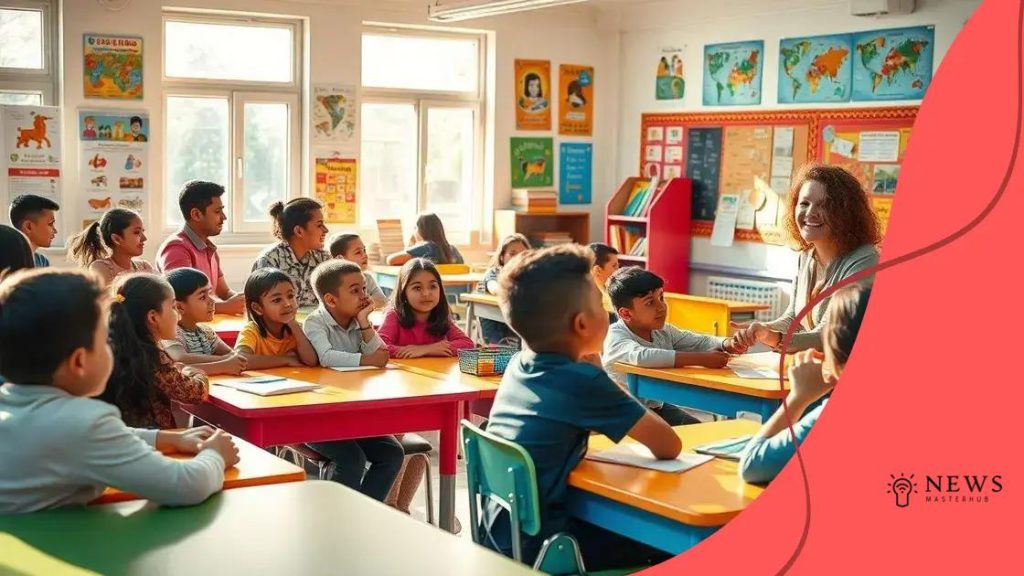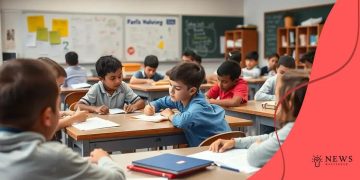Bilingual education programs: advantages and hurdles

Anúncios
Bilingual education programs enhance language skills, promote cultural awareness, and improve academic performance, while addressing challenges like resource availability and diverse student needs.
Bilingual education programs are shaping the way students learn languages in our diverse world. Have you wondered how these programs impact both students and teachers? Let’s explore their complexities and advantages together.
Understanding bilingual education programs
Understanding bilingual education programs involves exploring the methods and goals aimed at teaching students in two languages. It is essential to grasp how these programs function to appreciate their importance in our multicultural society.
Anúncios
Bilingual education typically caters to students who are native speakers of a language other than English. The main objective is to achieve proficiency in both the native language and English.
Types of Bilingual Education Programs
There are several types of bilingual education programs, each with unique approaches. Here are the main types:
- Two-way immersion: Students learn in both languages, promoting bilingualism among all students regardless of their native language.
- Submersion: Students are placed in English-speaking classes without additional support in their native language.
- Transitional bilingual education: Students gradually transition from their native language to English over time.
Each type serves a different purpose and matches various educational needs. For instance, two-way immersion enhances collaboration among students from diverse backgrounds, which can enrich their learning experience.
Anúncios
Goals of Bilingual Education
The goals of these programs emphasize achieving linguistic proficiency, academic success, and cultural awareness. By learning in two languages, students can:
- Enhance cognitive skills and multitasking abilities.
- Improve cultural appreciation and understanding.
- Prepare for a globalized job market.
Besides boosting academic performance, bilingual education also fosters a sense of identity among students. This approach not only aids in language acquisition but also promotes social integration.
Understanding how bilingual education programs operate helps educators and stakeholders create environments that support diverse learners effectively. With the right tools and methods, these programs can thrive, benefiting students and communities alike.
Key benefits of bilingual education
Key benefits of bilingual education encompass a variety of advantages for students and communities. Learning in two languages can significantly impact cognitive, social, and academic development.
One of the standout benefits is the enhancement of cognitive skills. Studies show that bilingual students often outperform their monolingual peers in problem-solving and critical thinking. This cognitive flexibility is essential for navigating complex tasks in today’s world.
Improved Academic Performance
Bilingual education can lead to improved academic performance. Here are some aspects of this benefit:
- Students gain a deeper understanding of their native language, which may bolster their English skills.
- Lessons taught in two languages help reinforce knowledge and skills across different subjects.
- Greater literacy skills, as students learn to read and write in both languages.
Additionally, these programs often foster a positive attitude towards learning. When students see their culture and language represented in the classroom, they are more engaged and motivated.
Cultural Awareness and Sensitivity
Bilingual education promotes cultural awareness and sensitivity among students. Learning different languages introduces them to new cultures and perspectives. This exposure prepares them to thrive in a globalized society.
As students interact with diverse peers, they develop empathy and understanding. Building connections with classmates from different backgrounds also enhances social skills. Furthermore, students become better communicators, which is crucial in both personal and professional settings.
The ability to communicate in more than one language opens up numerous opportunities. It can lead to better job prospects in our interconnected world. Employers value bilingual individuals for their edge in dealing with international clients and markets.
In conclusion, the broad range of benefits offered by bilingual education lays a strong foundation for lifelong learning and success. Both cognitive growth and cultural appreciation enrich the lives of students.
Challenges faced in bilingual classrooms

Challenges faced in bilingual classrooms are essential to understand as we strive for effective educational practices. While the benefits of bilingual education are significant, there are obstacles that teachers and students may encounter.
One of the primary challenges is the language proficiency gap among students. Some may excel in their native language, while others may struggle with English. This disparity can lead to frustration and hinder collaboration in group activities.
Resource Availability
Another challenge is the limited availability of resources. Many schools do not have sufficient materials or trained staff to effectively implement bilingual programs. Here are some key factors to consider:
- A lack of bilingual books and learning tools can restrict students’ engagement.
- Teachers may not receive adequate training to support two language learners.
- Funding cuts can limit the development of specialized programs.
These limitations can affect the quality of education that students receive. When teachers lack resources, they may struggle to deliver effective lessons that cater to bilingual students’ needs.
Cultural Differences
Cultural differences among students can also create challenges within bilingual classrooms. Students may come from various backgrounds, which influences their learning styles and interactions. Navigating these cultural dynamics can be complex.
Teachers often find it necessary to foster an inclusive environment that respects different cultural perspectives. If not addressed, these cultural disparities can lead to misunderstandings or tensions among students. Promoting understanding and respect is crucial for a harmonious classroom.
Finally, parental involvement can present a hurdle. Some parents may feel disconnected from the education process if they are not fluent in English. Encouraging parental engagement in both languages can enhance the connection between home and school, ultimately benefiting student outcomes. Effective communication with parents is vital for students’ success.
Implementing effective bilingual strategies
Implementing effective bilingual strategies is crucial for enhancing the educational experience of students in bilingual classrooms. These strategies not only support language acquisition but also promote a deeper understanding of content across subjects.
One important approach is integrated language development. This method intertwines language learning with subject matter instruction. By offering lessons that incorporate the target language, teachers encourage students to practice their language skills in real contexts.
Utilizing Cooperative Learning
Cooperative learning is another successful strategy that fosters teamwork among students. This approach allows students to work together and communicate in both languages. Here are some key aspects of utilizing cooperative learning:
- Students can share knowledge and cultural perspectives.
- They practice both languages, enhancing fluency.
- Group activities build confidence and social skills.
This collaborative environment is beneficial for all students, creating a sense of community. When students feel supported, their motivation to learn increases.
Incorporating Technology
The use of technology can also enhance bilingual education. Digital tools and resources provide engaging platforms for language practice. For example, language learning apps and interactive software can complement traditional teaching methods.
Additionally, online resources mean students can access a wide range of materials in both languages. This exposure increases their language proficiency and cultural knowledge. Teachers can create assignments that utilize these tools, blending technology with language learning seamlessly.
Regular assessment of student progress is vital in implementing these strategies. Teachers should monitor language development and content comprehension consistently. Assessment helps identify areas where students may need additional support. By tailoring instruction based on these evaluations, educators can better meet individual needs.
Finally, fostering a supportive classroom atmosphere is essential. Celebrating cultural diversity and encouraging open communication reinforces students’ confidence in their language abilities. When students feel valued, they are more likely to participate actively and take risks in their language learning journey.
Future of bilingual education initiatives
Future of bilingual education initiatives holds significant promise as schools continue to adapt to the needs of an increasingly diverse student population. With changing demographics and global communication, these initiatives are becoming more essential than ever.
One trend shaping the future is the emphasis on dual-language programs. These programs not only teach students in their native language but also immerse them in a second language. As educational leaders recognize the benefits of bilingualism, more schools are likely to implement these models to support bilingual learners.
Increased Funding for Bilingual Education
Future initiatives may also see increased funding aimed at improving resources for bilingual education. Financial support can enhance teacher training and provide necessary materials. Here are some anticipated areas of focus:
- Development of bilingual curricula that are engaging and effective.
- Investment in professional development for educators to strengthen their instructional strategies.
- Enhancement of technology tools that facilitate language learning.
As resources increase, teachers will have the support they need to create dynamic bilingual classrooms, helping students thrive in both languages.
Collaboration with Community Organizations
Collaboration between schools and community organizations is another crucial trend. Partnerships can enrich bilingual programs by integrating cultural experiences and resources. Engaging families in the learning process is vital for success and ensures that the community supports bilingual education.
These collaborations can provide students with real-world contexts for their language skills, reinforcing their learning through cultural events and activities. Schools can invite community members to share their cultural heritage, which enriches the curriculum while fostering inclusion.
As the future of bilingual education evolves, focusing on policy changes that support these initiatives will be essential. Advocates will need to emphasize the importance of bilingual programs to policymakers, demonstrating their value in preparation for a globalized world.
In summary, the future of bilingual education initiatives looks bright, with a focus on dual-language programs, increased funding, and community collaboration. Emphasizing these elements will help shape an environment where bilingualism is celebrated and supported.
FAQ – Frequently Asked Questions About Bilingual Education Programs
What are the main goals of bilingual education programs?
The main goals include developing proficiency in two languages, promoting academic success, and enhancing cultural awareness among students.
What challenges do teachers face in bilingual classrooms?
Teachers often encounter issues such as language proficiency gaps among students, limited resources, and the need to navigate cultural differences.
How can technology support bilingual education?
Technology can provide interactive tools and resources, making language learning more engaging and accessible for students.
What is the benefit of community involvement in bilingual education?
Community involvement helps create a supportive environment for students, enriches learning experiences, and fosters cultural appreciation.





